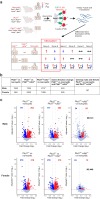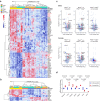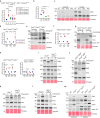Glis2 is an early effector of polycystin signaling and a target for therapy in polycystic kidney disease
- PMID: 38693102
- PMCID: PMC11063051
- DOI: 10.1038/s41467-024-48025-6
Glis2 is an early effector of polycystin signaling and a target for therapy in polycystic kidney disease
Abstract
Mouse models of autosomal dominant polycystic kidney disease (ADPKD) show that intact primary cilia are required for cyst growth following the inactivation of polycystin-1. The signaling pathways underlying this process, termed cilia-dependent cyst activation (CDCA), remain unknown. Using translating ribosome affinity purification RNASeq on mouse kidneys with polycystin-1 and cilia inactivation before cyst formation, we identify the differential 'CDCA pattern' translatome specifically dysregulated in kidney tubule cells destined to form cysts. From this, Glis2 emerges as a candidate functional effector of polycystin signaling and CDCA. In vitro changes in Glis2 expression mirror the polycystin- and cilia-dependent changes observed in kidney tissue, validating Glis2 as a cell culture-based indicator of polycystin function related to cyst formation. Inactivation of Glis2 suppresses polycystic kidney disease in mouse models of ADPKD, and pharmacological targeting of Glis2 with antisense oligonucleotides slows disease progression. Glis2 transcript and protein is a functional target of CDCA and a potential therapeutic target for treating ADPKD.
© 2024. The Author(s).
Conflict of interest statement
S.S. is a consultant for, and a scientific co-founder with equity interest in Sen Therapeutics. T.A.B.3rd was an employee of Ionis Pharmaceuticals at the time of this study. There are no more competing interests.
Figures






Similar articles
-
Cyclin-Dependent Kinase 1 Activity Is a Driver of Cyst Growth in Polycystic Kidney Disease.J Am Soc Nephrol. 2021 Jan;32(1):41-51. doi: 10.1681/ASN.2020040511. Epub 2020 Oct 12. J Am Soc Nephrol. 2021. PMID: 33046531 Free PMC article.
-
Cilia and polycystic kidney disease.Semin Cell Dev Biol. 2021 Feb;110:139-148. doi: 10.1016/j.semcdb.2020.05.003. Epub 2020 May 28. Semin Cell Dev Biol. 2021. PMID: 32475690 Review.
-
Inhibition of Hedgehog signaling does not mitigate polycystic kidney disease severity in a Pkd1 mutant mouse model.J Cell Sci. 2025 Oct 15;138(20):jcs264133. doi: 10.1242/jcs.264133. Epub 2025 Jul 31. J Cell Sci. 2025. PMID: 40554762
-
Polycystic kidney disease: novel insights into polycystin function.Trends Mol Med. 2023 Apr;29(4):268-281. doi: 10.1016/j.molmed.2023.01.005. Epub 2023 Feb 15. Trends Mol Med. 2023. PMID: 36805211 Review.
-
The role of the co-chaperone DNAJB11 in polycystic kidney disease: Molecular mechanisms and cellular origin of cyst formation.FASEB J. 2024 Nov 15;38(21):e70162. doi: 10.1096/fj.202401763R. FASEB J. 2024. PMID: 39530576
Cited by
-
Glis3 is a modifier of cyst progression in autosomal dominant polycystic kidney disease.bioRxiv [Preprint]. 2025 Jun 9:2025.06.08.658051. doi: 10.1101/2025.06.08.658051. bioRxiv. 2025. PMID: 40661540 Free PMC article. Preprint.
-
Physiologic mechanisms underlying polycystic kidney disease.Physiol Rev. 2025 Jul 1;105(3):1553-1607. doi: 10.1152/physrev.00018.2024. Epub 2025 Feb 12. Physiol Rev. 2025. PMID: 39938884 Free PMC article. Review.
-
Treating the Untreatable: Antisense Oligonucleotides as an Individualized Therapy for Rare Genetic Kidney Diseases.J Am Soc Nephrol. 2024 Dec 1;35(12):1774-1777. doi: 10.1681/ASN.0000000532. Epub 2024 Sep 27. J Am Soc Nephrol. 2024. PMID: 39331470 No abstract available.
-
Metabolic reprogramming in polycystic kidney disease and other renal ciliopathies.EMBO Mol Med. 2025 Jun;17(6):1191-1202. doi: 10.1038/s44321-025-00239-x. Epub 2025 Apr 22. EMBO Mol Med. 2025. PMID: 40263625 Free PMC article. Review.
References
Publication types
MeSH terms
Substances
Grants and funding
LinkOut - more resources
Full Text Sources
Molecular Biology Databases
Research Materials

